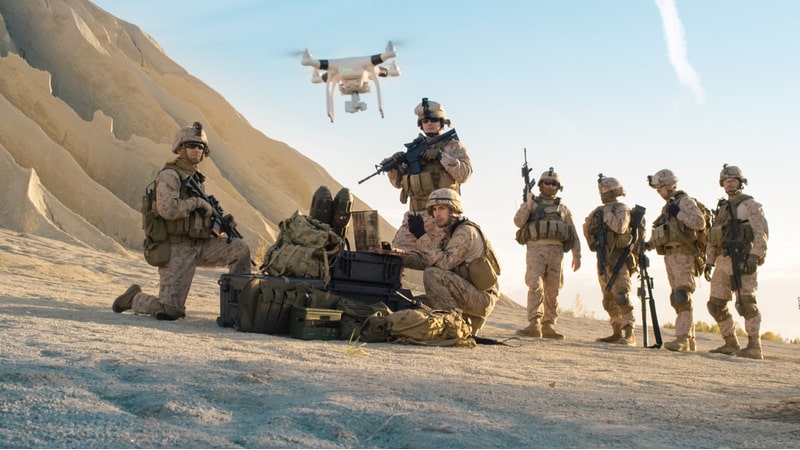
President Donald Trump on June 6 signed an executive order that seeks to expand the approved use of unmanned aircraft systems (UAS) – better known as drone aircraft – in United States airspace, employ AI technologies in reviews of drone applications, and smooth the way for the military to make more extensive use of drone craft.
“The United States must accelerate the safe commercialization of drone technologies and fully integrate UAS into the National Airspace System,” the order says.
“The time has come to accelerate testing and to enable routine drone operations, scale up domestic production, and expand the export of trusted, American-manufactured drone technologies to global markets,” the order states. “Building a strong and secure domestic drone sector is vital to reducing reliance on foreign sources, strengthening critical supply chains, and ensuring that the benefits of this technology are delivered to the American people.”
Current U.S. policy on domestic drone use is managed by the Federal Aviation Administration (FAA) and aims at the safe integration of drones into U.S. airspace.
Current rules include FAA safety guidelines, different registration rules for commercial and hobbyist drones, the use of remote identification technologies, operating restrictions including no-fly zones around airports, maintaining visual line of sight (VLOS) between drone and operator, and licensing requirements for commercial drone operators, among others.
Airspace Integration
The new White House order declares it is U.S. policy to accelerate “the safe integration of UAS into the National Airspace System through timely, risk-based rulemaking that enables routine advanced operations.”
The order also aims to advance “the domestic commercialization of UAS technologies at scale, including their safe and secure manufacturing, production, and integration, by supporting industry-led innovation, reducing regulatory uncertainty, and streamlining approvals and certification processes, including for consumer goods delivery and environmental reviews.”
It further aims to support “strengthening the domestic drone industrial base and promoting the export of trusted, American-manufactured UAS through updated economic policies and regulation, coordinated trade, financing, and foreign engagement tools.”
To further the airspace integration goals, the White House order gives the Transportation Department (DoT) 30 days to issue a proposed rule “enabling routine Beyond Visual Line of Sight (BVLOS) operations for UAS for commercial and public safety purposes,” and 240 days to issue a final rule.
Also within 30 days, DoT and FAA will establish metrics for “assessing the performance and safety of BVLOS operations.” Within six months, the agencies will report any regulatory barriers to BVLOS implementation with recommendations to the White House Office of Science and Technology Policy to address those through rulemaking or legislation.
DoT and FAA will have 240 days to “publish an updated roadmap for the integration of civil UAS into the National Airspace System,” the order says.
AI for Applications
The order also gives DoT and FAA four months to “initiate the deployment of artificial intelligence (AI) tools to assist in and expedite the review of UAS waiver applications.”
Those AI tools, the White House said, will “support performance- and risk-based evaluation of proposed operations,” identify precedents and recommend mitigation measures, and help FAA identify approval patterns that may require additional rulemaking,
DoT and FAA also will “explore options to ensure that UAS flights beginning and ending in United States airspace, or United States-owned facilities in the high seas, can operate without being subject to the onerous requirements applicable to manned aircraft engaging in international navigation as referenced in the Convention on International Civil Aviation,” the order says.
The two agencies also will work to make sure that all FAA UAS test ranges “are fully utilized to support the development, testing, and scaling of American drone technologies, with a focus on BVLOS operations, increasingly autonomous operations, advanced air mobility, and other advanced operations,” the order says.
DoT also will “prioritize the generation of safety and performance data at UAS Test Ranges to inform FAA rulemaking, identify regulatory gaps and operational challenges, and support the integration of emerging UAS capabilities into the National Airspace System,” according to the text of the order.
DoD Requirements
The order also states that the Defense Department (DoD) “must be able to procure, integrate, and train using low-cost, high-performing drones manufactured in the United States.”
To enable that goal, the order requires the secretary of defense to “ensure all platforms on the Defense Innovation Unit’s (DIU) Blue UAS List can, as soon as possible and to the fullest extent practicable, operate on all military installations or ranges without requiring an exception to policy.”
The order gives DoD 90 days to expand DIU’s Blue UAS List to include all drones and critical drone components compliant with section 848 of the National Defense Authorization Act for Fiscal Year 2020 (“FY 2020 NDAA”) (Public Law 116-92) to the fullest extent practicable, and to update the Blue UAS List on a monthly basis.
The order also requires DoD to prioritize the purchase of U.S.-made drones, and to make sure that compliance with current regulations “does not inhibit the rapid adoption of drone technology required to exceed the capabilities of our foreign adversaries.”
Finally, the order gives DoD 90 days to task military department leaders “to identify programs that would be more cost efficient or lethal if replaced by UAS.”
